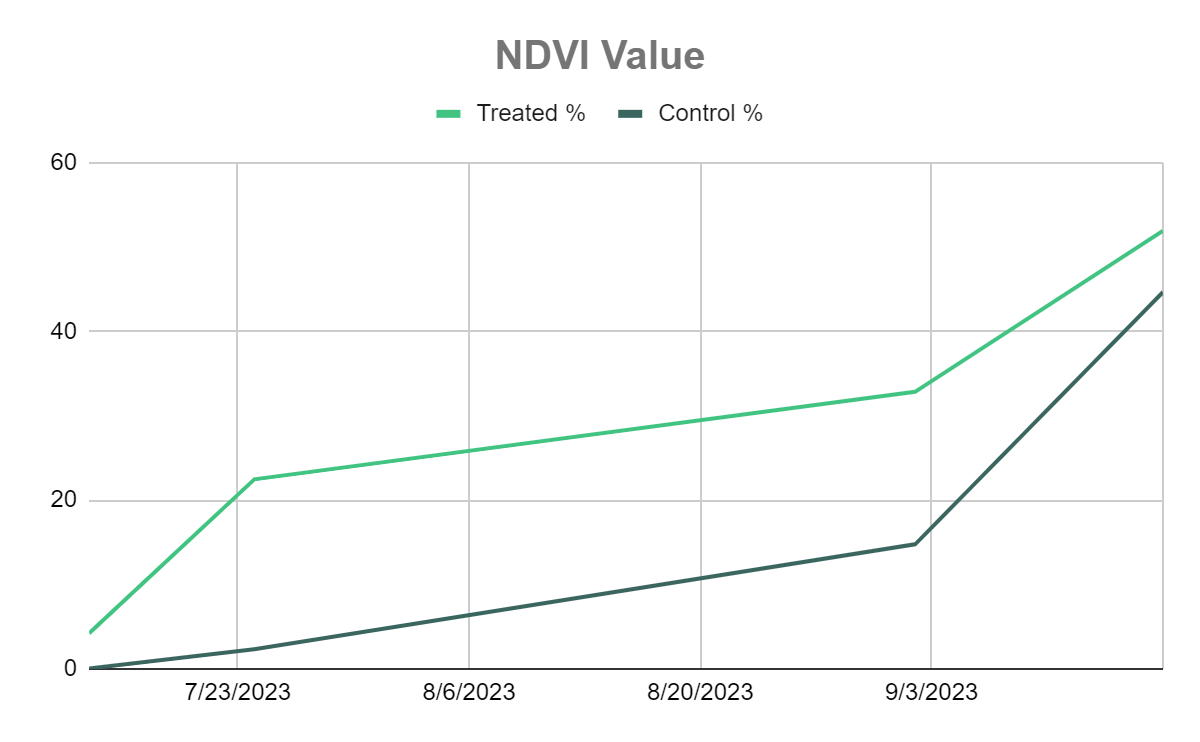BACKGROUND
Production Year: 2023
Location: Hartley County, TX
Planting Date: 6/18/2023
Harvest Date: 10/15/2023
Seed Variety: Pioneer 0817
Planting Rate: 38,000 seeds per acre
Flow Device: 10-inch
TerraNet™: General Wellness
Set Up: Separate Fields
Acres: 250 per field
Challenge(s): Running out of groundwater, high heat during pollination affecting yield, fertility.
Goal(s): Higher yield, higher biomass, better crop health, 35-ton silage
Trial Results:
- 8.49% silage yield increase
- 520% return on investment
- $197.72 per acre in additional income
- 19.93% less irrigation water applied
METHODS
- Soil type and slope were evaluated to confirm comparability between both fields .
- Weather and historical performance were considered during the set-up and analysis phase of the case study.
- Fertilizer rates, planting populations and dates, irrigation rates, and harvest dates remained consistent between control and treatment fields.
- A paired T-Test and Least Significant Difference analysis were performed on this data.
- Each field was monitored throughout the growing season to note any developmental differences and ensure that any differences in farming practices and implementations were noted as well.
Data Collected
- Yield – Manual
- Satellite Imagery
- Drone Imaging
- Scouting – General
Soil Map Data
The treated field consists of loam soil textures, while the control field is entirely clay loam. Based on the differences in soil textures and semi-arid climate, the soil in the control field would theoretically retain more moisture than the treated field (Oklahoma State University). Therefore, the treatment field started with a disadvantage for soil moisture retention.
Weather
Precipitation amounts were very high prior to planting but slowed significantly to stay within an average range during July and August. In September, however, the rainfall amounts dropped and the area received .66 inches of rain compared to the average of 1.46 inches. During this time, temperatures were 2 to 3 degrees higher than average. This, coupled with lower rainfall amounts at the point of crop development, could lead to a much quicker dry-down and less time for grain development.
RESULTS
Yield

Based on the harvest data provided by the grower, the UpTerra treatment generated a 8.49% increase in tons per acre of harvested sillage compared to the control field.



Treatment field received 19.93% less water applied through irrigation. 4.54 gallons per acre of irrigated water were applied to the treatment field, while the control field received 5.67 gallons per acre of irrigated water.

Satellite Imagery
The satellite imagery taken during the 2023 growing season shows typical biomass accumulation of the treatment field and control field during early-season crop development. The NDVI values of each field are graphed below. The graph shows earlier plant development in the treated field. Higher NDVI values were maintained throughout the season, indicating sustained higher plant health.

CONCLUSION
The results indicate that the UpTerra System positively affected yield and plant development. Although the treated field had a more challenging soil type than the control for this trial and was expected to perform less favorably, our team observed superior performance on the UpTerra treated field. Specifically, there was a yield increase of 8.49% in corn silage with 24.9% less irrigation water applied. The grower had a 520% return on investment, generating approximately $197.72 per acre in additional income. Since growing practices were the same on either side of the field, the data team concluded that there was a notable effect of the UpTerra System on production for this product evaluation.

